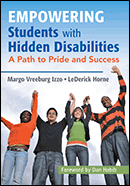5 Steps to Strong Self-Advocacy Skills for Students with Disabilities
September 12, 2023
 As they approach adulthood, students who have a “hidden disability”—such as dyslexia, ADHD, or autism—need to master the art of disclosing what their disability is, how it affects them in a variety of situations, and what supports they need to succeed. Students often learn these self-advocacy skills through trial-and-error in real-world situations, but it’s helpful for students to learn these skills in advance and practice speaking up for themselves. Today’s post, excerpted and adapted from Empowering Students with Hidden Disabilities by Margo Vreeburg Izzo & LeDerick Horne, introduces a five-step process to support students in developing self-advocacy skills.
As they approach adulthood, students who have a “hidden disability”—such as dyslexia, ADHD, or autism—need to master the art of disclosing what their disability is, how it affects them in a variety of situations, and what supports they need to succeed. Students often learn these self-advocacy skills through trial-and-error in real-world situations, but it’s helpful for students to learn these skills in advance and practice speaking up for themselves. Today’s post, excerpted and adapted from Empowering Students with Hidden Disabilities by Margo Vreeburg Izzo & LeDerick Horne, introduces a five-step process to support students in developing self-advocacy skills.
Step 1: Communicate needs.
Communicating what you need to another person is at the heart of all self-advocacy. Students have many choices when it comes to communication, so the first thing students should decide is the best mode of communication given the situation. Sometimes a face-to-face conversation is best, but it might be better to communicate via email, printed letter, or over the phone.
Step 2: Choose the best setting.
After students have picked a form of communication, it’s important for them to determine the best setting to use when advocating. For example, students might be more successful if they talk one to one with their teacher after school or during a free period instead of in class. Determining the best time and the best place can really help leverage a self-advocate’s ability to get what they want in order to be successful.
Step 3: Be polite and use social skills.
Once students have determined the best form of communication and an appropriate setting to advocate, the next thing to decide is how they will ask for what they need. Remind them that being polite when asking for anything is more than just good manners; it is also a proven tactic that can help influence a person to act in the students’ favor. Starting a relationship on a positive note can make advocating much easier.
Step 4: Use disability language.
Students should use language such as “because of my disability, I have trouble with…” or, “I have autism so I will need…” when it comes time to talk about how their disability will affect them in any given setting. Students convey how their disability affects them personally when they use the name of a diagnosed disability when asking for any support or accommodation. In addition, students with disabilities are protected by a host of laws against discrimination and exclusion. If they choose not to use the language of disability and instead use statements such as, “I’m not good at this part of my job” or “I get frustrated when I have to read out loud,” then students are not being responsible self-advocates and might be mistaken for someone who is just “lazy” or uninterested.
Step 5: Offer alternatives.
Students should offer alternatives after they have made it clear that they have a disability that might interfere with their performance in a given setting. Employers, educators, and people in general might not have the training or cultural competency to know exactly how to support them, so it is important for students to develop a list of accommodations (written out or in their minds) that will help them perform at their best. Creating this list in advance can help students sound more confident and competent as advocates. For example, “I have an auditory processing disorder, so I can participate in discussions more effectively if I have a handout of key discussion questions” or “I have difficulty with reading, so I use my laptop’s text-to-speech technology to listen to the text.”
Review these five steps with students and help them practice self-advocacy skills by role-playing various scenarios that they may encounter in school and community settings. And for more guidance on helping students with non-visible disabilities dream big and unlock their full potential, get the empowering guidebook behind today’s post.




Write a Comment
Your email address will not be published. Required fields are marked *
Post a Comment